What is ergonomics keyboard? What kinds of ergonomic keyboards are there?
Ergonomics keyboard is a specially designed keyboard, to help bring comfort to users' hands, reduce discomfort or difficult operations. These keyboards can have concave or descending keys, the keys are set at a reasonable distance, separating the two sides from the center point into a V-shape . All of which are intended to provide a pleasant user experience, more comfortable for users.
Types of ergonomic keyboards
Split keyboard (Split keyboard)
The fixed split keyboard has keys divided into 2 or 3 groups, allowing users to type at different angles, not at a single corner like the usual straight keyboard.
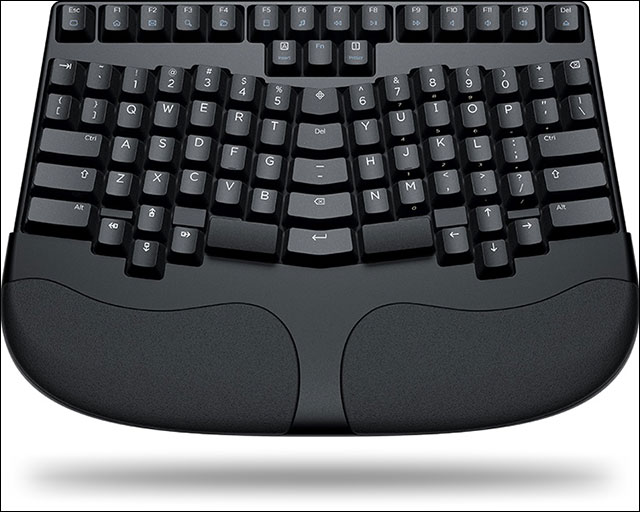
Custom split keyboard with keys divided into sections, corners can be easily changed.
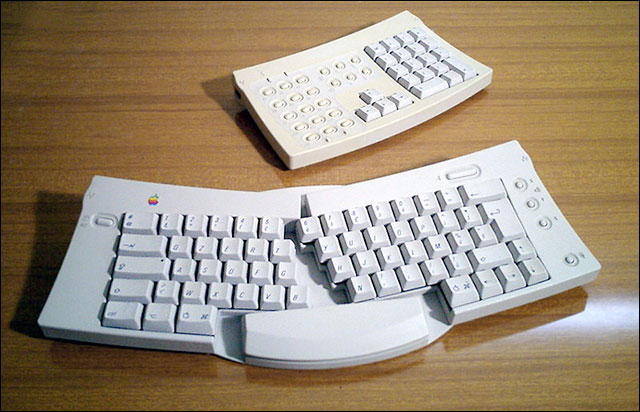
Split keyboard can be customized by Apple
Block keyboard (Contoured keyboard)
The next development of the concept of dividing keyboards is a block keyboard, such as the 1977 Maltron or the newer Kinesis Advantage series. This keyboard places the keys on both sides according to the approximate width of the shoulder, the function keys in the middle to type with the thumb. This type of structure requires very little movement of the arms and wrists.

This is an example of a block keyboard
Handheld keyboard (Handheld keyboards)
This is a keyboard designed like gaming handles, which can be held on the hand instead of on a flat surface like regular keyboards. Users can walk in the room or lean back on the chair and still type normally.
Some variants of this keyboard include a trackball mouse, which allows mouse movement and typing right on the handheld keyboard.
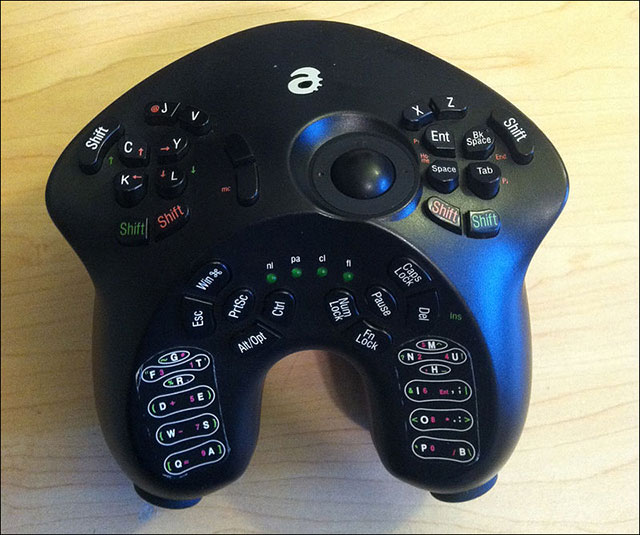
AlphaGrip is an example of a portable keyboard
Corner split keyboard (Angle split keyboard)
Corner keyboard (also known as Klockenburg keyboard) is also quite similar to a split keyboard but the middle part is raised so that the index finger is in a position higher than the other fingers when typing. Key Ovation has created a Goldtouch industrial keyboard with a corner keyboard and is adjustable.
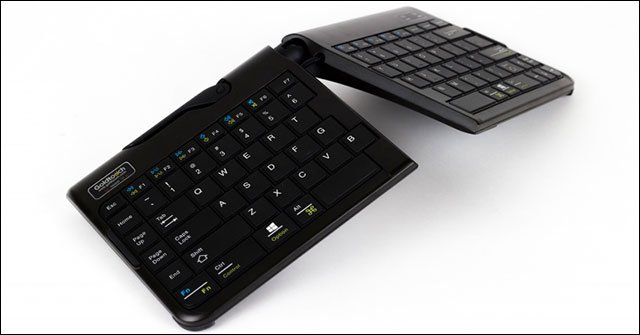
The corner keyboard has a higher center
Different types of ergonomic keyboards
Other ergonomics keyboards have a fixed vertical key and are aligned so that when typing, the hand will be perpendicular to the ground, thumbs up or type to allow rotation. A few keyboards that don't have the design of each key are a letter, like a keyer or keyless keyboard.
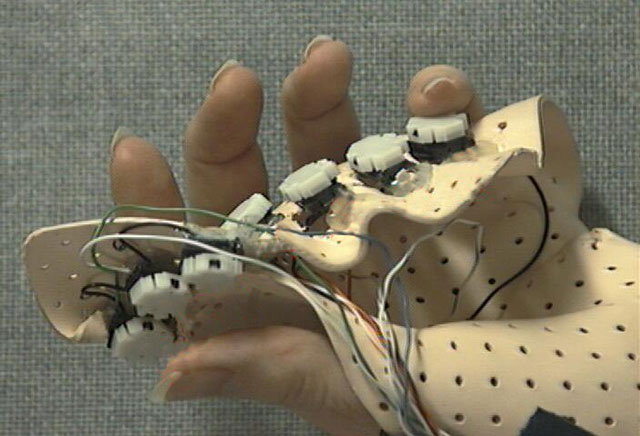
You may have seen the keyboard keyer on Stephen Hawking's talking device
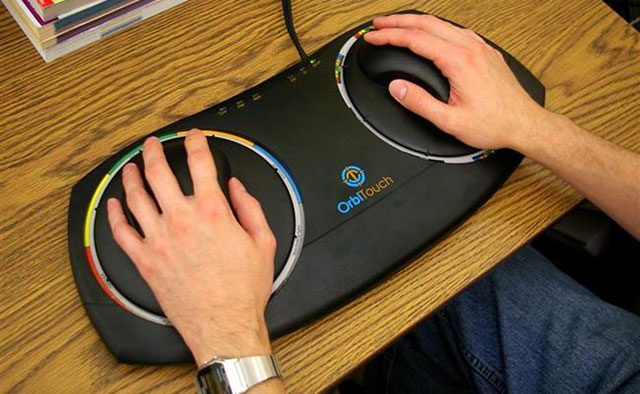
Keyless keyboards have no keys
See more:
- Best ergonomic (Ergonomic) keyboard 2018
- Look back at the phones possessing a very special keyboard
- Ultra-thin keyboard, foldable and pocket-sized like a cover, costs just over VND 20,000
You should read it
- Top 5 best mechanical keyboard brands today
- How does a mechanical keyboard work?
- See the strange mechanical keyboards of the Vietnam Mechanical Keyboard Association
- 6 ways to make mechanical keyboards less noisy
- What is a mechanical keyboard? Compare mechanical keyboards and regular keyboards
- How to change the mechanical keyboard switch at home with 5 steps
- 5 best mechanical keyboards for Mac in 2024
- Top best wireless keyboard for Mac and PC
May be interested
- Lessons from keyboards and Viruses come from?
 the arrangement of the keys on the computer keyboard we still use everyday contains a lot of interesting things.
the arrangement of the keys on the computer keyboard we still use everyday contains a lot of interesting things. - TOP 5 best wireless mechanical keyboards for super comfortable typing
 wireless mechanical keyboards are often quite expensive. therefore, before spending a large amount of money to own it, you often wonder which type of wireless mechanical keyboard to choose. below are the top 5 best wireless mechanical keyboards of 2022 that you can refer to !!
wireless mechanical keyboards are often quite expensive. therefore, before spending a large amount of money to own it, you often wonder which type of wireless mechanical keyboard to choose. below are the top 5 best wireless mechanical keyboards of 2022 that you can refer to !! - 10 incredible keyboards
 the familiar standard rectangular keyboards are a source of new creativity for manufacturers. they put the keyboard in a stylish tablecloth, curled it into a pocket or put it anywhere with c
the familiar standard rectangular keyboards are a source of new creativity for manufacturers. they put the keyboard in a stylish tablecloth, curled it into a pocket or put it anywhere with c - Check out the top 5 silent mechanical keyboards for office workers
 silent mechanical keyboards are increasingly popular among office workers. let's explore the top 5 quietest mechanical keyboards in this article by tipsmake.
silent mechanical keyboards are increasingly popular among office workers. let's explore the top 5 quietest mechanical keyboards in this article by tipsmake. - How to clean your Keyboard
 experts say keyboards are even dirtier than the toilet. here's how you can return it to sparkling condition.
experts say keyboards are even dirtier than the toilet. here's how you can return it to sparkling condition. - What is an RGB LED keyboard? Differences with other keyboards
 nowadays, rgb led keyboards are very commonly used, so what is an rgb led keyboard and what's the difference? let's find out.
nowadays, rgb led keyboards are very commonly used, so what is an rgb led keyboard and what's the difference? let's find out. - Top 5 keyboards with red switches worth buying
 top 5 keyboards with red switch keyboards to buy in 2023, genuine supply at hacom. genuine cheap red switch mechanical keyboard, brown switch, blue switch.
top 5 keyboards with red switch keyboards to buy in 2023, genuine supply at hacom. genuine cheap red switch mechanical keyboard, brown switch, blue switch. - 5 reasons to buy an external keyboard for laptops
 laptop keyboards can cause a lot of discomfort for some people, such as keys that are too hard, do not work properly or even completely stop working.
laptop keyboards can cause a lot of discomfort for some people, such as keys that are too hard, do not work properly or even completely stop working. - What is Hot Swap? Benefits of Hot Swap on mechanical keyboards
 what is hot swap? why should you use hot swap? top 5 most popular hot swap keyboards today for you. hot swap disassembly and installation instructions are simple and quick.
what is hot swap? why should you use hot swap? top 5 most popular hot swap keyboards today for you. hot swap disassembly and installation instructions are simple and quick. - 18 Professional Surface Pro Keyboard Troubleshooting Solutions
 this article explains how to repair surface pro keyboards like type cover and touch cover, third-party wired and wireless keyboards, windows 10 and windows 11 touch keyboards.
this article explains how to repair surface pro keyboards like type cover and touch cover, third-party wired and wireless keyboards, windows 10 and windows 11 touch keyboards.










 What is top-level domain name (TLD) and how do they work?
What is top-level domain name (TLD) and how do they work? Which company is Huawei?
Which company is Huawei? List of Internet domain names by country
List of Internet domain names by country Learn about Xiaomi cult phone carrier and the secret to help them succeed
Learn about Xiaomi cult phone carrier and the secret to help them succeed What is a sandbox and how does it sandbox a program?
What is a sandbox and how does it sandbox a program?